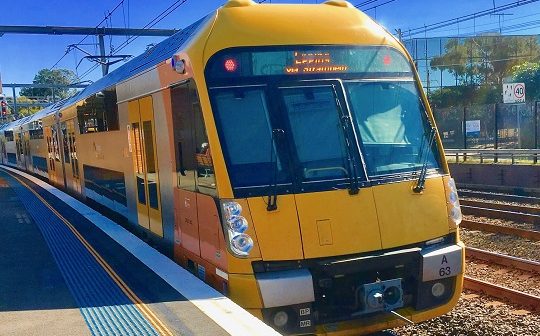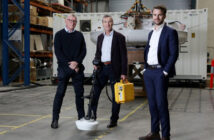
Mark Edmonds pioneering security and safety work for the busiest rail network in Australia
In 2011 when Mark Edmonds was invited to join Sydney Trains’ security operation – after being in a contractor role for four years, to being full-time – his first response was that he’d do the job without a salary if he could just keep one percent of the savings he’d achieve.
It was an offer made half in jest, and a sign of his confidence that big, systemic improvements were possible.
And over the decade as manager of security capability, he has been proved right. During that time, the rail operator has pioneered new approaches to using technology in a number of important security and safety areas: compliance and enforcement; lone worker safety; response to emergency incidents and alerts; and better use of video surveillance and alarm systems.
Mark is perhaps not a typical security manager, either by background or temperament. He spent the first 11 years of his career working in Australian signals intelligence, including two years with the National Security Agency in America, before becoming a security and risk manager for Qantas.
As a result, he’s more confident with technology than those who move into commercial security from classic police or military backgrounds. And he’s particularly focused on business strategy and return-on-investment.
 At Sydney Trains, he says, he found a role that particularly suited him. The network, which comes under the auspices of Transport for New South Wales, comprises urban and suburban rail services that operate over 175 stations, eight lines and 800-plus kilometres of track, and supports NSW TrainLink’s intercity and regional operations. Pre-COVID it was handling more than a million customer journeys every day during peak times.
At Sydney Trains, he says, he found a role that particularly suited him. The network, which comes under the auspices of Transport for New South Wales, comprises urban and suburban rail services that operate over 175 stations, eight lines and 800-plus kilometres of track, and supports NSW TrainLink’s intercity and regional operations. Pre-COVID it was handling more than a million customer journeys every day during peak times.
“I ended up fitting into the technology and capability space, not because that’s my speciality – although I’ve obviously had a lot of exposure to it, particularly in signals intelligence where you get a lot of exposure to computers, communications and technology systems – but simply because I think there was a dearth of that kind of knowledge in the security sector.”
Mark’s first major project with Sydney Trains was a security monitoring system upgrade, integrating previously dispersed locally monitored video surveillance into a seamless solution monitored from a central facility. It was a complex project that delivered ongoing annual savings of around AUS$2.5m per annum.
It was a process of untangling that also simplified the path to further improvements in the surveillance infrastructure. The result has been significantly boosted monitoring coverage across the whole Sydney Trains network.
Since Mark’s initial involvement, every project he’s focused on has been ROI positive.
There were some smaller projects, delivering annual savings of around $200k, such as using covert video to target vandals ‘tagging’ trains with graffiti. Mark describes this ‘no big deal’ in financial terms, but still important for their impact because of the extensive media interest and publicity generated, and the positive knock-on effects on public perceptions of crime and safety.
“The vandals involved were not kids but actually serious offenders by and large. Tagging trains is an expensive habit and you need to fund that habit by being employed or using the proceeds of crime.”
The campaign to target these offenders involved locating covert cameras (with the help of a retired detective) to give the police a crucial 10-minute advanced warning whenever an attack was likely.
A much bigger and more complex challenge was modernising the fare compliance system.
By 2014, Sydney Trains had already moved to its Opal electronic ticketing system, but inspectors still used pen and paper to write infringement notices. Copies of each notice were passed to the government’s debt collection agency to try to recoup lost revenue. But the introduction of Opal necessitated a new approach to checking that passengers had paid the correct fare, with visual checks on tickets no longer an option.
So, Sydney Trains set out to become the first rail operator to go fully electronic on fare compliance. Mark and his team developed a solution that would not only allow Opal cards to be checked, but that would integrate with a new electronic penalty notice system. And they wanted to use Samsung smart phones rather than expensive, dedicated devices.
When the new integrated system was rolled out, penalty revenues increased by around AUS$1.6m in the first year.
The entire process of developing and introducing the solution took around 9 months.
Mark’s most recent project – and another first for Sydney Trains – is perhaps the most ambitious innovation yet. It came about through a need to improve lone worker and station staff safety following the switch to Opal card ticketing and a desire to retire an obsolete personal alarm system that was expensive to operate and maintain. That change supported station staff being reassigned to duties on platforms and around station concourses in a safe way, instead of being limited to working inside ticket offices.
This greater staff visibility and improved interaction with customers was welcomed, but it also entailed greater risk, particularly during night shifts and in more remote locations.
To offset this, an advanced lone worker and emergency response solution was needed that would allow improved monitoring of staff safety, wherever team members were on the rail network.
A nine-month pilot project was launched in collaboration with CriticalArc. The company was already well established as a provider of advanced safety, security and emergency management solutions to government sector agencies and in the global higher education sector.
 In 2019, Mark’s team initiated a project that aimed to demonstrate whether the SafeZone solution could also provide an answer for some of the most important challenges in the rail environment.
In 2019, Mark’s team initiated a project that aimed to demonstrate whether the SafeZone solution could also provide an answer for some of the most important challenges in the rail environment.
The added potential bonus was that it offered a combination of functions in a unified solution, rather than more costly disparate systems. These functions included targeted and mass communications, geo-location pinpointing and emergency-call. For example, the technology would let any member of staff to request help directly from the security first responders using a smart phone app or dedicated wearable device, and it would allow the control room operators to pinpoint the identity and precise location of that individual down to two or three metres accuracy, anywhere on the rail network. It would also allow alerts and notifications to be sent to team members individually, or as defined by their location or group status.
“When we did the pilot, the first thing that appealed was that we didn’t have to use our own IT. CriticalArc provided all the infrastructure. If I’d wanted to put a new app on our own system and monitor it on our own IT network I’d have had to go to Transport for South Wales, and it would have taken much longer. CriticalArc’s approach meant that we could do the pilot without much risk.”
The exercise involved around 30 staff and ran in consultation with the unions. Within days, feedback on the new communications and safety capability was overwhelmingly positive, so at the end of the trial a decision was taken to go out to tender with four alternative solutions being shortlisted, including SafeZone itself.
“To make sure that our evaluation committee made the best selection, each competing technology was also presented to a stakeholder panel, which comprised customer service attendants, fare compliance officers, station managers, security managers and our IT specialists. This stakeholder group was given a remit to focus on functionality, not cost. In other words, we wanted them to assess the features on offer, and select the best solution.”
By a significant margin both the stakeholder group and the evaluation committee identified SafeZone as the best technology. They concluded that it hit the ‘sweet spot’ for performance and functionality. And importantly, it also represented best value.
So, over the last several months, Mark and a team from Customer Service have worked with CriticalArc to implement the new system, and to communicate its value to all Sydney Trains employees. Post-COVID plans to expand the capability to other parts of the business, and to NSW TrainLink, are well underway.
Today, the technology is helping Sydney Trains keep their employees safe, wherever they are on the train network, and so far, it has been used to ensure successful outcomes to incidents ranging from medical emergencies to anti-social behaviour to wildfires.
Having proved that innovation can deliver substantive improvements Sydney Trains has paved the way for adoption of this approach across the wider New South Wales public transport network – all part of ongoing efforts to instil a culture of safety and to make sure that employees are valued, inspired, and supported.






